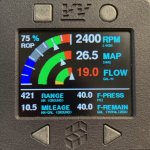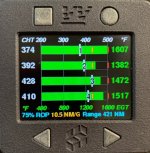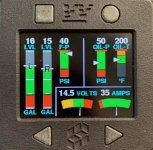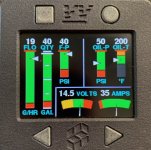vlittle
Well Known Member
This is a continuation of my old Arduino thread https://vansairforce.net/community/showthread.php?t=151119&highlight=arduino, which has covered a lot of territory and is getting long and complicated. Anyone who has followed the old thread know that Rob Prior and I have been developing open-source avionic displays for the last 3 years. We successfully introduced a suite of flight instruments and a tailBeaconX control head.
I have been working on engine instruments for at least that long, but never released them because there were too many configuration options to support, and there is no industry standardization on how to display all of the various engine parameters.
Recently, I received an email from a pilot who was using the flight displays as a backup to his Dynon HDX. He experienced a screen failure on his HDX, but was able to use our displays to successfully complete his flight. His one request was to include engine instruments in the software so that he could monitor critical engine parameters. Since I already had the code prototypes complete, it was easy for me to roll into a software load.
Of course, nothing is ever that simple... recent updates to the software development tools introduced some bugs that took some wrangling to work around. All this means is that I can't yet post the source code. However, I am able to generate binary files that are easy to upload to existing instruments (either the M5Stack or the huVVer-AVI displays) using Over-The-Air (OTA) updates.
Soooo.... I am introducing a Beta (trial) version of my Engine Instruments as an extension to the Flight Instrument library. Anyone interested in trying them out and providing feedback, please PM me and I will email the file(s).
Here's some Pics. Please note: The raw data for these is provided by a Dynon SkyView display. Garmin G3X also works, but without the fuel economy and range computations. Note that the last two photos look similar. The first one provides fuel level gauges, while the second one shows fuel flow and fuel remaining--- for aircraft that don't have fuel gauges (ahem).
The Flight Instruments library now contains 11 gauges, not including diagnostic pages, all selectable in flight. A favorite (power on default) gauge can be selected, and unused gauges can be turned off.




I have been working on engine instruments for at least that long, but never released them because there were too many configuration options to support, and there is no industry standardization on how to display all of the various engine parameters.
Recently, I received an email from a pilot who was using the flight displays as a backup to his Dynon HDX. He experienced a screen failure on his HDX, but was able to use our displays to successfully complete his flight. His one request was to include engine instruments in the software so that he could monitor critical engine parameters. Since I already had the code prototypes complete, it was easy for me to roll into a software load.
Of course, nothing is ever that simple... recent updates to the software development tools introduced some bugs that took some wrangling to work around. All this means is that I can't yet post the source code. However, I am able to generate binary files that are easy to upload to existing instruments (either the M5Stack or the huVVer-AVI displays) using Over-The-Air (OTA) updates.
Soooo.... I am introducing a Beta (trial) version of my Engine Instruments as an extension to the Flight Instrument library. Anyone interested in trying them out and providing feedback, please PM me and I will email the file(s).
Here's some Pics. Please note: The raw data for these is provided by a Dynon SkyView display. Garmin G3X also works, but without the fuel economy and range computations. Note that the last two photos look similar. The first one provides fuel level gauges, while the second one shows fuel flow and fuel remaining--- for aircraft that don't have fuel gauges (ahem).
The Flight Instruments library now contains 11 gauges, not including diagnostic pages, all selectable in flight. A favorite (power on default) gauge can be selected, and unused gauges can be turned off.




Last edited:




